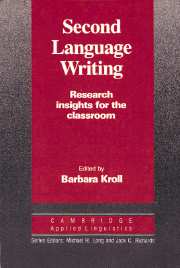Book contents
- Frontmatter
- Contents
- List of contributors
- Series editors' preface
- Preface
- Introduction
- I PHILOSOPHICAL UNDERPINNINGS OF SECOND LANGUAGE WRITING INSTRUCTION
- II CONSIDERATIONS FOR WRITING INSTRUCTION
- Chapter 7 Composing in English: effects of a first language on writing in English as a second language
- Chapter 8 The teaching of topical structure analysis as a revision strategy for ESL writers
- Chapter 9 What does time buy? ESL student performance on home versus class compositions
- Chapter 10 Feedback on compositions: teacher and student verbal reports
- Chapter 11 Teacher response to student writing: focus on form versus content
- Chapter 12 Responding to different topic types: a quantitative analysis from a contrastive rhetoric perspective
- Chapter 13 Writing with others' words: using background reading text in academic compositions
- Index
Chapter 8 - The teaching of topical structure analysis as a revision strategy for ESL writers
Published online by Cambridge University Press: 05 October 2012
- Frontmatter
- Contents
- List of contributors
- Series editors' preface
- Preface
- Introduction
- I PHILOSOPHICAL UNDERPINNINGS OF SECOND LANGUAGE WRITING INSTRUCTION
- II CONSIDERATIONS FOR WRITING INSTRUCTION
- Chapter 7 Composing in English: effects of a first language on writing in English as a second language
- Chapter 8 The teaching of topical structure analysis as a revision strategy for ESL writers
- Chapter 9 What does time buy? ESL student performance on home versus class compositions
- Chapter 10 Feedback on compositions: teacher and student verbal reports
- Chapter 11 Teacher response to student writing: focus on form versus content
- Chapter 12 Responding to different topic types: a quantitative analysis from a contrastive rhetoric perspective
- Chapter 13 Writing with others' words: using background reading text in academic compositions
- Index
Summary
In the process-centered approach to composition, writing is viewed as a recursive process in which students are encouraged to revise as they write and to produce multiple drafts of their essays. This approach toward writing instruction is based on an accumulating body of empirical support that suggests that this is the process successful and experienced writers typically follow when they write. Sommers (1978) was one of the pioneers in researching how native English-speaking writers revise. She noted what others have since confirmed: that inexperienced writers tend to revise at the lexical level only, and that they tend to adhere to rigid rules of style and usage regardless of appropriateness (see also Beach 1976; Perl 1979; Bridwell 1980; Flower and Hayes 1981; Faigley and Witte 1984; Freedman 1985; Anson 1989). Experienced writers, however, tend to revise at all levels (lexical, phrasal, sentential, etc.) and are more likely to make efforts to “shape the argument” to fit the writer's purpose.
If native speakers experience problems during revision, then probably it can be safely assumed that these problems also occur and are even more acute for the nonnative speaker. It is important that we teach ESL students to consider the situational and contextual causes of revision in a piece of writing. This chapter describes a promising new linguistically based revision strategy, topical structure analysis, that helps students to consider the discourse level in conjunction with the surface level of their writing.
- Type
- Chapter
- Information
- Second Language Writing (Cambridge Applied Linguistics)Research Insights for the Classroom, pp. 126 - 139Publisher: Cambridge University PressPrint publication year: 1990
- 15
- Cited by



